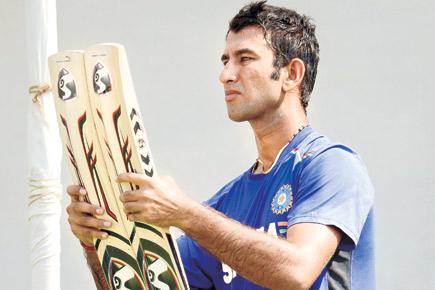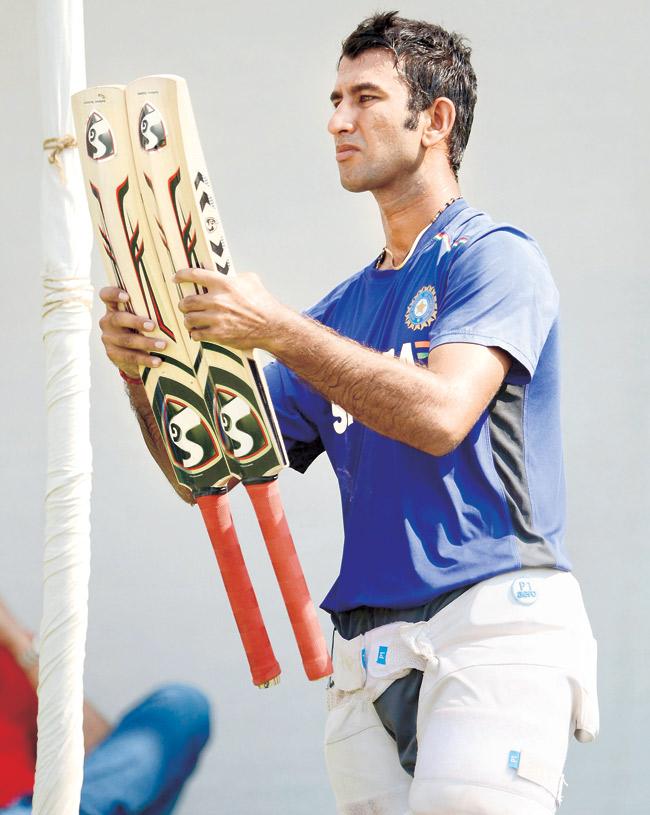While the batsman may not get enough chances in the Asia Cup or not thrive on his opportunity, the move to pick him in India's ODI squad will yield returns at World Cup 2015, writes Aakash Chopra

Cheteshwar Pujara. Pic/AFP
Selection, good or bad, always leads to a debate. Why was 'he' picked? Why wasn't 'he' picked? How long would you persist with 'that' player? Will 'this' player ever get a chance? It's impossible for the selectors to please everyone and still continue to do their job earnestly.
Cheteshwar Pujara. Pic/AFP
ADVERTISEMENT
Team selections ought to be about picking the 'right' team and not winning votes or catering to popular opinions. The current set of selectors deserve a pat on their back for being pragmatic. They've done the hard yards to see as many first-class matches as possible and have shown their vision in most of their choices.
Most importantly, they've sent out a loud and clear message that non-performers won't be persisted with. If you haven't scored or taken wickets, your reputation or past records won't matter. The most recent selection for the Asia Cup followed the same line. Both Suresh Raina and Ishant Sharma were shown the door for inconsistent performances and Cheteshwar Pujara has finally been given a go.
I have always been a vocal supporter of having Pujara in the ODI mix. In his brief international career, he's shown that he has what it takes to succeed at the top and, more importantly, has the ability to adapt. Even in Test cricket he isn't someone who plays in one gear, for he knows how to increase the tempo and scoring rate without taking undue risks. In fact, in the current set of Indian Test batsmen who've scored more than a 1000 Test runs he's only the second guy with a strike rate in the 50s.
India's poor record
But his selection is not just about what he brings to the table but also what the Indian team most likely wants going forward. The team hasn't won a single ODI in their last eight outings, which includes losing the series 0-4 to a team that is ranked eighth in the ODI rankings, New Zealand.
While bowlers have been announced the bigger culprit for India's woes, batting being the stronger suit, is equally guilty, if not more. India's bowling problems were well documented and hence an above par score shouldn't be surprising. But consistent batting failure has definitely become a matter of grave concern.
Dhawan, Rohit, Rahane, Raina have all fallen well short of expectations. That should make us think — do we need to sacrifice flair for solidity? Is a good looking 30 better than a scratchy 70? Latter is the answer to both these questions and hence the selection of Pujara. Pujara can be that guy who can assume the role of a floater.
If a wicket falls early, he could be the ideal No 3, for it is never wise to expose your best batsman (Kohli) to two new balls. If the openers are having a tough time, Pujara can also be your reserve opener, for he has the technique to see off the new ball/s. But there's a small caveat — both the situations mentioned are keeping in mind the trying conditions overseas.
Two new balls and a little bit of juice in the pitch, demands a different tactic and tighter technique. Since you're unlikely to be setting or chasing 300-plus scores often, the strike-rate of a little under 100 would also be
acceptable. In India's successful campaign down under in 2007-08, Gambhir scored 20 per cent of India's runs at a strike rate of 82. In the recent series against NZ, Williamson scored five consecutive fifties at less than a run-a-ball. That's a job you could trust Pujara to do well too.
Home conditions
Unfortunately, the same can't be said about the sub-continental conditions. In these conditions, the new ball doesn't pose a great threat. In fact, it provides an opportunity to score freely. The harder the ball, the further it goes on batting beauties. That's when you need free flowing stroke-makers at the top, ones who don't take their foot off the accelerator after pressing it right at the beginning.
Runs must flow in boundaries and if the gaps aren't available, the top order must not shy from taking the aerial route. These batsmen start their innings in fourth gear and keep moving upwards, for a score of 325 is the new 270 in the subcontinent. And that's where Pujara doesn't fit in India's scheme of things, for he's likely to slow things
down. He may have a lot of strokes in his armory, still he neither has the ability to clear the fence at will nor does he have the bravado to attempt it before scoring a sizeable individual score.
So, don't be surprised if Kohli doesn't give him enough chances in the Asia Cup or if he doesn't make the most of the chances coming his way. His inclusion is an investment for the future and hence his reign in the ODI line up should not be dependent on his success or the lack of it on sub-continental pitches. Given the fragility of India's new middle-order, it's imperative to invest in the talent that's likely to bring success when it matters the most, which is — the World Cup in 2015. Pujara is likely to be that guy!
0
India have not won a one-day international in their last eight games
 Subscribe today by clicking the link and stay updated with the latest news!" Click here!
Subscribe today by clicking the link and stay updated with the latest news!" Click here!






